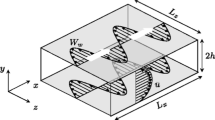Abstract
In this paper, a novel technique for drag reduction in turbulent flows is presented. The technique involves the modification of the large scales of turbulent flows and is a passive approach. The lateral transport of momentum, which is a dominant mechanism in turbulence, is attenuated by the introduction of moving shear-free surfaces (SFSes). This brings about a reduction in the drag. 2D simulations have been carried out for a turbulent channel flow using shear stress transport (SST) Reynolds-averaged Navier–Stokes (RANS) model and validated with the available experimental results. The interaction between the plates and the fluid is two way, and is enforced either by the use of a rigid body solver with moving mesh, or by considering the SFSes to be fixed at particular locations and then updating the velocities of the plates at those locations. The latter is equivalent to solving a fully developed flow in the moving mesh case. The number, shape, size and placement of the SFSes strongly influence the amount of drag reduction. The phenomenon is confirmed to be governed by a ‘slow’ turbulent time scale. Further, the efficacy of the method is seen to depend on the ratio of two time scales – an advection time scale indicating the ‘resident time’ near an SFS, and the turbulent time scale. In addition, the effectiveness of the approach is improved by judicious placement of multiple SFSes in the flow.























Similar content being viewed by others
References
Lumley J and Blossey P 1998 Control of turbulence. Annu. Rev. Fluid Mech. 30: 311–327
Karniadakis G E and Choi K S 2003 Mechanisms on transverse motions in turbulent wall flows. Annu. Rev. Fluid Mech. 35: 45–62
Berger T, Kim J, Lee C and Lim J 2000 Turbulent boundary layer control utilizing the Lorentz force. Phys. Fluids 12(3): 631–649
Crawford C H and Karniadakis G E 1997 Reynolds stress analysis of EMHD-controlled wall turbulence, part I: streamwise forcing. Phys. Fluids 9(3): 788–806
Osullivan P L and Biringen S 1998 Direct numerical simulations of low Reynolds number turbulent channel flow with EMHD control. Phys. Fluids 10(5): 1169–1181
Sahlin A, Johansson A V and Alfredsson P H 1988 The possibility of drag reduction by outer layer manipulators in turbulent boundary layers. Phys. Fluids 31(10): 2814–2820
Kim J and Bewley T R 2007 A linear systems approach to flow control. Annu. Rev. Fluid Mech. 39: 383–417
Bushnell D M, Hefner J N and Ash R L 1977 Effect of compliant wall motion on turbulent boundary layer. Phys. Fluids 20(10): S31–S48 (part II)
Christodoulou C, Liu K N and Joseph D D 1991 Combined effects of riblets and polymers on drag reduction in pipes. Phys. Fluids A Fluid Dyn. 3(5): 995–996
Ferrante A and Elghobashi S 2004 On the physical mechanism of drag reduction in a spatially developing turbulent boundary layer laden with microbubbles. J. Fluid Mech. 503: 345–355
Pal S, Deutsch S and Merkle C L 1989 A comparison of shear stress fluctuation statistics between microbubble modified and polymer modified turbulent boundary layers. Phys. Fluids A 1(8): 1360–1362
Sanders W C, Winkel E S, Dowling D R, Perlin M and Ceccio S L 2006 Bubble friction drag reduction in a high-Reynolds-number flat-plate turbulent boundary layer. J. Fluid Mech. 552: 353–380
Xu J, Maxey M R and Karniadakis G E 2002 Numerical simulation of turbulent drag reduction using micro-bubbles. J. Fluid Mech. 468: 271–281
Ogata S and Watanabe K 2002 Limiting maximum drag-reduction asymptote for the moment coefficient of a rotating disk in drag-reducing surfactant solution. J. Fluid Mech. 457: 325–337
Pashkewitz J S, Dubief Y, Dimitropoulos D, Shaqfeh E S G and Moin P 2004 Numerical simulation of turbulent drag reduction using rigid fibres. J. Fluid Mech. 518: 281–317
Oldroyd J G 1949 In Proceedings of the International Congress on Rheology, North-Holland, Amsterdam, sec. II, p. 130
Toms B A 1949 In Proceedings of the International Congress on Rheology, North-Holland, Amsterdam, sec. II, p. 135
Lumley J L 1969 Drag reduction by additives. Annu. Rev. Fluid Mech. 1: 367–384
Berman N S 1978 Drag reduction by polymers. Annu. Rev. Fluid Mech. 10: 47–64
Sreenivasan K R and White C M 2000 The onset of drag reduction by dilute polymer additives, and the maximum drag reduction asymptote. J. Fluid Mech. 409: 149–164
Liberzon A, Guala M, Kinzelbach W and Tsinober A 2006 On the turbulent kinetic energy production and dissipation in dilute polymer solutions. Phys. Fluids 18(125101): 1–12
Cholemari M R and Srinivasan B 2011 Investigation of novel drag reduction strategies. Project report submitted to AR&DB, May 2011
Lal S 2012 Flux enhancement by shear-free surfaces in a turbulent convection. MTech. Thesis, Department of Applied Mechanics, IIT, Delhi
Majhi N K 2012 Drag reduction by modification of large scales of an internal turbulent flow. MTech. Thesis, Department of Applied Mechanics, IIT, Delhi
RajaVamsi G 2009 Drag reduction by modifying the large scales of a turbulent channel flow. MTech. Thesis, Department of Applied Mechanics, IIT, Delhi
Sahoo T 2010 Drag reduction by modifying the large scales of a turbulent flow. MTech. Thesis, Department of Applied Mechanics, IIT, Delhi
Cholemari M R and Arakeri J H 2005 Experiments and a model of turbulent exchange flow in a vertical pipe. Int. J. Heat Mass Transf. 48(21): 4467–4473
Cholemari M R and Arakeri J H 2009 Axially homogeneous, zero mean flow buoyancy-driven turbulence in a vertical pipe. J. Fluid Mech. 621: 69–102
Menter F R 1994 Two-equation eddy-viscosity turbulence models for engineering applications. AIAA J. 32: 1598–1605
Pope S B 2000 Turbulent flows. Cambridge University Press
Author information
Authors and Affiliations
Corresponding author
Rights and permissions
About this article
Cite this article
Sood, A.K., Cholemari, M.R. & Srinivasan, B. Drag reduction by the introduction of shear-free surfaces in a turbulent channel flow. Sādhanā 42, 433–445 (2017). https://doi.org/10.1007/s12046-017-0593-0
Received:
Revised:
Accepted:
Published:
Issue Date:
DOI: https://doi.org/10.1007/s12046-017-0593-0




